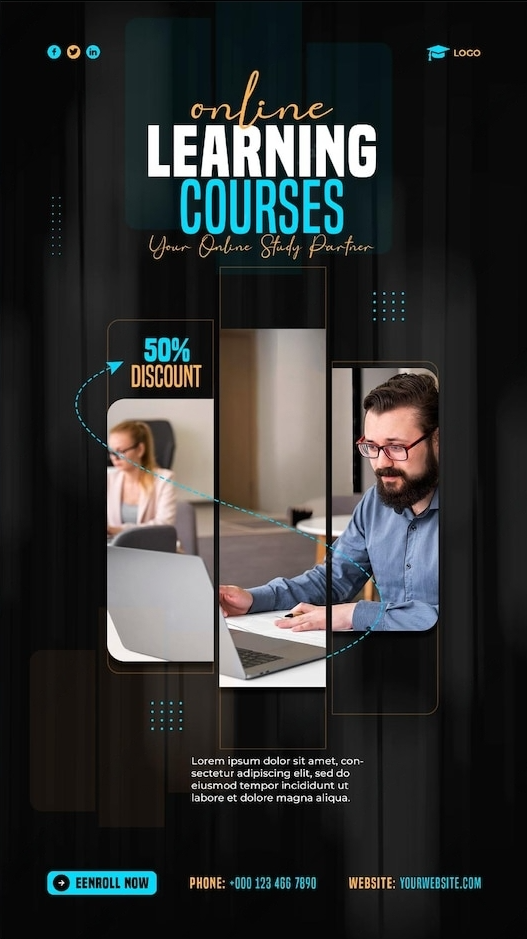How to Make Money Teaching Live Online Coding Classes

In today’s digital era, online education has surged to the forefront, and coding classes have experienced unprecedented popularity. As a proficient coder in languages like Python, JavaScript, Ruby, or others, you have a remarkable opportunity to share your knowledge and make money teaching live online coding classes.
This comprehensive guide will take you on a detailed journey, providing in-depth insights and strategies for becoming a successful online coding instructor.
To help you fully grasp this lucrative venture, we’ll break this guide into two parts. First, we’ll cover the essentials for getting started and building your live online coding class. Then, we’ll explore ways to maximize your earnings, ensure your success, and secure your future growth as an online coding instructor.
Getting Started and Building Your Live Online Coding Class
The Basics of Online Coding Classes
Online coding classes come in various formats, each with its unique benefits and characteristics. Understanding these formats is crucial as you embark on your journey. Here’s a breakdown of the most common types:
- Pre-recorded Video Courses: In this format, you record your coding lessons in advance, and students can access them at their own pace. This provides flexibility for both you and your students.
- Interactive Live Sessions: Live classes offer real-time interaction with your students. They can ask questions, seek clarification, and engage in discussions while you teach.
- One-on-One Tutoring: For a personalized learning experience, you can offer one-on-one tutoring, where you work directly with a student. This allows you to tailor your teaching to the individual’s needs.
The Advantages of Teaching Online
Teaching coding online comes with several advantages:
- Global Reach: You can reach students from all around the world, expanding your potential student base.
- Work from Home: Online teaching allows you to work from the comfort of your home or any location you prefer.
- Diverse Audience: You can attract a wide range of students with varying backgrounds and goals.
Understanding Your Target Audience
To succeed as an online coding instructor, you must tailor your classes to your target audience. Consider the following factors:
- Skill Levels: Determine the skill levels you want to cater to. Are you focusing on beginners, intermediate learners, or advanced coders?
- Age Groups: Consider the age groups you’d like to teach. Are you targeting school-age students, college students, or professionals looking to upskill?
- Learning Preferences: Be aware of your students’ learning preferences. Some may prefer a structured course, while others may benefit from a more flexible learning environment.
Getting Started with Online Coding Instruction
Before you start teaching live online coding classes, you need to take some essential steps:
Assess Your Qualifications and Skills
Begin by assessing your qualifications and skills. To be an effective coding instructor, you should:
- Be Proficient in Coding Languages: You must have a strong command of the coding languages you plan to teach. This expertise will instill confidence in your students and help you deliver high-quality instruction.
- Possess Effective Teaching Skills: Teaching coding is not just about knowing the subject; it’s about effectively communicating your knowledge to students. Consider whether you have the teaching skills required to engage and educate your audience.
Determine Which Coding Languages You Will Teach
Coding is a vast field with numerous programming languages. You need to decide which languages you will teach. This choice should align with your expertise and the demand in the market.
Obtain the Proper Equipment
To conduct live online coding classes, you’ll need the right equipment:
- Computer: You’ll need a reliable computer to run coding environments, display teaching materials, and communicate with your students.
- Webcam: A quality webcam ensures clear video during live sessions, making your teaching more engaging.
- Microphone: An external microphone can significantly improve audio quality, helping your students understand you better.
Set Up Accounts on Teaching Platforms
You have two primary options for hosting your online coding classes:
- Established Online Learning Platforms: Platforms like Udemy, Coursera, or Skillshare offer a vast user base and ready-made infrastructure for hosting courses. While they provide a broad audience, you may have limited control over pricing and course structure.
- Create Your Website: Building your website allows for more control over your courses. You can set your pricing, design the curriculum, and shape the user experience. However, it demands more effort in terms of marketing and audience building.
In your decision-making process, consider your goals, target audience, and the level of control you want over your classes.
Create Curriculum and Lesson Plans
Once you’ve determined the platform for your classes, the next step is to create a comprehensive curriculum and detailed lesson plans. These should include:
- Course Structure: How you’ll organize your lessons and materials.
- Learning Objectives: What students will gain from your classes.
- Syllabus: A breakdown of the topics you’ll cover throughout the course.
- Coding Exercises: Hands-on exercises that allow students to practice what they’ve learned.
- Assessments: Methods for evaluating your students’ progress and understanding.
Required Skills and Expertise
Being a proficient coder is just one aspect of becoming an effective online coding instructor. Here’s what you need to excel in this role:
Proficiency in Coding Languages
Your expertise in coding languages is the foundation of your role. It’s essential to:
- Understand the coding languages you’ll teach inside and out.
- Be prepared to solve complex problems and provide clear explanations.
- Stay updated with the latest developments in your chosen coding languages.
Effective Teaching and Communication Skills
Teaching coding is more than just imparting knowledge. Effective instruction requires:
- The ability to convey complex concepts in a way that’s easy for students to understand.
- Patience in addressing questions and challenges students encounter.
- The skill to adapt your teaching style to suit
different learning preferences.
Creating a Teaching Plan and Curriculum
Designing a structured teaching plan and curriculum is pivotal. Your teaching plan should cover:
- The overall course structure.
- Specific learning objectives for each section of the course.
- The order in which you’ll cover coding concepts.
- The pace at which you’ll teach and the duration of each lesson.
Designing a Curriculum
The curriculum is at the heart of your online coding class. It should be well-structured, engaging, and focused on the needs of your target audience.
Structuring Your Class for Different Skill Levels
When designing your curriculum, consider how you’ll accommodate learners with varying skill levels. You can structure your class to cater to:
- Beginners: Start with the fundamentals and progressively introduce more advanced topics.
- Intermediate Learners: Assume a basic understanding of coding and dive deeper into complex concepts.
- Advanced Coders: Offer advanced courses that cover specialized topics or in-depth coding techniques.
Incorporating Interactive Coding Exercises
Practical exercises are essential for helping students apply what they’ve learned. Incorporate interactive coding exercises into your lessons to reinforce their understanding. These exercises can range from simple coding challenges to comprehensive projects that mimic real-world coding scenarios.
Balancing Theory and Hands-On Practice
A well-rounded curriculum strikes the right balance between theory and hands-on practice. While theory provides essential knowledge, hands-on practice allows students to build the practical skills they need. Your curriculum should include both theoretical lessons and opportunities for students to apply what they’ve learned through coding exercises.
Setting the Right Price
Pricing your online coding classes is a critical decision. You want to strike a balance between affordability for your students and fair compensation for your expertise.
Pricing Strategies for Your Coding Classes

Several pricing strategies are common in the world of online education:
- One-Time Payment: Students pay a single fee for access to your course.
- Subscription: You can offer monthly or annual subscriptions, giving students ongoing access to your content.
- Tiered Pricing: Create different pricing tiers that offer various levels of access or additional resources.
- Freemium Model: Offer a basic course for free, with the option for students to upgrade to a premium version for more in-depth content and features.
Consider market research to understand the pricing landscape for coding classes in your niche. Pricing can evolve over time as you gain experience and a reputation in the industry.
Offering Free Trial Sessions
Attracting your first students can be challenging. To build trust and credibility, consider offering free trial sessions. These sessions give prospective students a taste of your teaching style and the quality of your content. A positive trial experience can encourage students to enroll in your full course.
Marketing Your Coding Classes
Once you’ve set up your online coding classes and curriculum, it’s time to market them effectively. Building a personal brand as an online coding instructor is essential to attract and retain students.
Building a Personal Brand
Establishing a personal brand as an online coding instructor is a long-term investment in your success. Consider these steps:
- Create a Website: Building a professional website where you showcase your expertise, courses, and teaching style is crucial. Your website is the central hub for your online presence.
- Content Marketing: Share valuable content related to coding and your courses through blog posts, tutorials, or videos. This positions you as an authority in your field.
- Online Profiles: Create and maintain profiles on professional platforms like LinkedIn, as well as educational platforms where you offer your courses.
- Networking: Connect with other educators, coding experts, and potential students through social media, forums, and online communities.
- Testimonials: Encourage your students to provide testimonials or reviews about your courses. Positive feedback from satisfied students can significantly boost your reputation.
Effective Online Marketing Strategies
Online marketing plays a pivotal role in attracting students to your online coding classes:
- Search Engine Optimization (SEO): Optimize your website and content for search engines to increase your visibility to potential students.
- Email Marketing: Build an email list to keep students informed about your courses and engage with them directly.
- Paid Advertising: Consider online advertising on platforms like Google Ads or social media to reach a broader audience.
- Affiliate Marketing: Partner with other content creators or educators who can promote your courses to their audience in exchange for a commission.
- Social Media Marketing: Utilize social media platforms to promote your courses, share coding tips, and interact with potential students.
- Webinars and Workshops: Hosting webinars and workshops on coding topics can attract potential students and establish you as an expert in your field.
Leveraging Social Media and Community Engagement
Active participation in online communities related to coding is another way to promote your courses. Engage in discussions, answer questions, and offer valuable insights. By establishing yourself as an authority in these communities, you can naturally attract students interested in your courses.
Teaching Live Online Coding Classes
Now that you’ve laid the foundation, it’s time to delve into the art of instruction for live online coding classes.
The Art of Instruction
Creating an engaging and interactive learning environment is essential for your students’ success.
Developing Engaging Lesson Plans
Your lesson plans should be well-structured, with clear objectives and outcomes for each session. Consider:
- Introduction: Start each lesson with an engaging introduction to the topic. Explain why it’s relevant and what students will learn.
- Interactive Elements: Incorporate interactive elements like quizzes, polls, or discussions to keep students engaged throughout the lesson.
- Hands-On Exercises: Include hands-on exercises where students can practice coding concepts in real-time.
- Real-World Examples: Provide real-world examples to illustrate the practical applications of the coding concepts you’re teaching.
Fostering Active Participation
Engage your students actively during live sessions:
- Encourage Questions: Create an open and safe environment for students to ask questions. Address these questions in real-time.
- Peer Interaction: Encourage students to interact with their peers. This can be done through group activities, discussions, or collaborative coding projects.
- Feedback: Provide feedback on students’ coding work, offering constructive guidance for improvement.
- Problem-Solving: Include problem-solving activities that challenge students to apply what they’ve learned to practical situations.
Providing Real-Time Feedback and Support
During live online coding classes, students will encounter challenges and may have questions. It’s essential to offer real-time support and feedback:
- Live Q&A Sessions: Schedule live Q&A sessions where students can ask questions and receive immediate answers.
- Chat Support: Use chat tools or platforms to provide quick answers to student queries.
- Feedback Mechanisms: Develop a process for students to submit their work for review and receive feedback.
- One-on-One Support: Offer one-on-one support sessions for students who need additional help.
Strategies for Handling Technical Difficulties
Technical difficulties can occur during live online sessions. Being prepared to address them is essential:
- Backup Plans: Have a backup plan in case technical issues arise. This could involve using alternative tools or rescheduling the session.
- Technical Support: Offer technical support to students who encounter problems. Provide clear instructions on how to troubleshoot common technical issues.
- Recording Sessions: Record your live sessions so that students who experience technical problems can access the content later.
Building a Community
Fostering a supportive learning community is invaluable for your students and your success as an online coding instructor. Consider these strategies:
Creating a sense of community within your online coding classes can enhance the learning experience for your students. Here’s how to go about it:
Fostering a Supportive Learning Community Encourage Interaction: Actively promote student interaction through discussions, forums, or social media groups related to your courses. This allows students to connect, share their progress, and collaborate on coding projects.
Mentorship Opportunities: Offer mentorship or coaching programs where experienced students can guide newcomers. Mentorship provides an additional layer of support and guidance.
Collaborative Projects: Encourage students to collaborate on coding projects. Group projects can be an excellent way for them to apply what they’ve learned and learn from one another.
Networking Events: Organize networking events or webinars where students can connect with industry professionals or other learners. Networking can open doors to job opportunities and collaborations.
Encouraging Networking and Mentorship By facilitating networking and mentorship opportunities, you empower your students to build valuable connections in the tech industry and support one another in their coding journey. This not only adds significant value to your classes but also strengthens your reputation as a coding instructor.
Maximizing Your Earnings, Ensuring Success, and Future Growth
Maximizing Your Earnings
Now that your online coding classes are up and running, it’s time to explore strategies to maximize your earnings and ensure long-term success as an online coding instructor.
Expanding Your Reach
To reach a broader audience and increase your income potential, consider the following strategies:
Offering Advanced and Specialized Courses
Diversify your course offerings by providing advanced and specialized coding courses. These courses can cater to a variety of learning needs, including niche areas, specific coding languages, or advanced coding techniques. Offering specialized courses at a higher price point can significantly boost your revenue.
Attracting International Students
Expanding your reach globally is a smart move. Attracting international students not only broadens your audience but also brings diverse perspectives to your classes. To make your content more accessible to non-English speakers, consider providing translated materials or subtitles in different languages.
Partnering with Other Coding Educators
Collaborating with other coding educators can be mutually beneficial. Partner with instructors who offer complementary coding courses to create course bundles or joint programs. This collaborative approach can expand your reach, introduce your courses to a broader audience, and enhance your earning potential.
Handling Payments and Finances
As your classes grow and your income increases, effective payment management and financial considerations become crucial. Here are some key points to consider:
Setting Up Payment Gateways
Choose reliable payment gateways to handle tuition and fees. Ensure that the payment process is smooth, secure, and convenient for both you and your students. Consider popular payment processing platforms to provide a seamless experience.
Managing Tuition, Fees, and Subscriptions
Keep a meticulous record of student payments, including tuition fees and subscription payments. Using dedicated accounting software or online platforms designed for educators can simplify the management of your finances. Efficient financial management is essential for maintaining a sustainable and profitable teaching business.
Dealing with Taxes and Financial Considerations
As an online educator, you should be aware of the tax implications of your income. Consult with a financial advisor or accountant to ensure you’re managing your finances effectively and compliant with tax regulations in your jurisdiction.
Ensuring Success and Future Growth
Measuring your success as an online coding instructor and staying informed about industry changes are critical for your long-term growth and career sustainability.
Measuring Success
To gauge your success as an online coding instructor, take the following steps:
Set Specific Goals
Define clear, achievable goals for your online coding instruction career. These goals can include targets for the number of students, course completions, income milestones, or other relevant metrics. Setting specific objectives will help you track your progress effectively.
Collect Student Feedback and Testimonials
Encourage your students to provide feedback and testimonials about your courses. This valuable information offers insights into your teaching methods and the overall student experience. Positive testimonials can also serve as powerful marketing tools, attracting more students to your courses.
Adapt Your Teaching Approach
Based on the feedback you receive and the results you’ve achieved, be willing to adapt and refine your teaching approach. Continuous improvement is essential for long-term success in online education. By staying responsive to your students’ needs and preferences, you can ensure a positive learning experience.
Staying Informed and Updated
The tech industry is in a constant state of evolution, with new coding trends and industry changes emerging regularly. To stay ahead and provide the most relevant content to your students, consider the following practices:
Keep Up with Coding Trends
Stay informed about the latest coding trends, emerging technologies, and industry developments. Engage in continuous learning to ensure that your courses remain up to date and relevant. This commitment to staying current will enhance your credibility and the quality of your instruction.
Attend Webinars and Conferences
Participate in webinars, conferences, and workshops related to coding and online education. These events provide opportunities to expand your knowledge, network with professionals in the field, and gain insights into best practices in online instruction.
Prepare for the Future of Online Education
The field of online education is continually evolving. Keep an eye on trends in e-learning, teaching methods, and technology. By adopting innovative approaches to online coding instruction, you can ensure that your courses remain competitive and that you are prepared for the future of online education.
Conclusion
Embarking on a journey as an online coding instructor offers countless opportunities to make money, share your knowledge, and contribute to the tech community. By following this comprehensive guide, you can transform your coding expertise into a fulfilling and financially rewarding career.
Embrace the advantages of online instruction, design engaging curricula, and establish a strong online presence. Your journey as an online coding instructor begins with a single step, and with dedication, you can create a positive impact on students worldwide while building a sustainable income stream.
Your knowledge and expertise in coding can make a difference in the lives of many and provide you with a rewarding and financially viable career.
Related Articles
24 Websites That Will Pay You to Test Websites and Apps
Comprehensive Comparison of Leading Low-Code Platforms; Appian, Mendix, and OutSystems: Choosing the Best Low-Code Platform
Mastering the Art of Making Money Teaching Tech Skills Online: Skillshare and Beyond
How Generative AI is Transforming Financial Services















